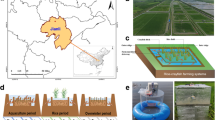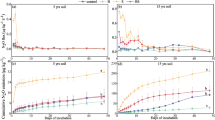Abstract
Measurements of N2O emissions from conventional rice cultivation (CRC), CRC with straw mulching, system of rice intensification (SRI) and SRI with plastic film mulching were conducted through static chamber/gas-chromatography techniques. The results show that daily fluctuation of N2O emissions in jointing stage are much higher than in others. A type peak of N2O seasonal emission presented between jointing and bearing stages companying with high daily average temperature and low precipitation. Biomass and leaf stomatal conductance were observed. Total quantities of N2O emission were budgeted. The results showed that after jointing stage the average N2O emission flux of SRI with plastic film mulching increased significantly than CRC with straw mulching and SRI, the leaf stomatal conductance of those showed the same trend (P<0.05). Yield and total quantity of N2O emission in CRC with straw mulching enhanced 13.7% and 10.7% compared with those of CRC, respectively. The total quantity of N2O emissions reduced 3.6% in SRI with plastic film mulching compared with CRC, however, the yield increase of that was not significant.
Similar content being viewed by others
References
Mosier A R. Soil Processes and Global Change [J].Biol Fertil of Soils, 1998,27:221–229.
Cicerone R J, Oremland R S. Biogeochemical Aspects of Atmospheric Methane [J].Global Biogeochemical Cycles, 1988,2:299–327.
Chang C, Cho C M, Janzen H H. Nitrous Oxide Emission from Long-term Manured Soils [J].Soil Sci Soc Am J, 1998,62:677–682.
Mahmood T, Ali R, Sajjad M I,et al. Denitrification and Total Fertilizer-N Losses from an Irirgated Cotton Field [J].Biol Fertil Soil, 2000,31:270–278.
Kaiser E A, Kohrs K, Kucke M,et al. Nitrous Oxide Release from Arable Soil: Importance of N-Fertilization, Crops and Temporal Variation [J].Soil Biol Biolchem, 1998,30: 1553–1563.
Houghton J T, Ding Y, Griggs D J,et al. Climate Change 2001:A Scientific Basis, Intergrovernmental Panel on Climate Change [M]. Cambridge: Cambridge University Press, 2001.
Machida T, Nakazawa T, Fujii Y S,et al. Increase in the Atmospheric Nitrous Oxide Concentrations during the Last 250 Years [J].Geophys Res Lett, 1995,22:2921–2924.
Battle M, Bender M, Sowers T,et al. Atmospheric Gas Concentrations over the Past Century Measured in Air from Firm at the South Pole [J].Nature, 1996,383:231–235.
Moiser A R, Duxbury J M, Freney J R,et al. Assessing and Mitigating N2O Emissions from Agricultural Soils [J].Climitic Change, 1998b,40:7–38.
Kroeze C, Mosier A, Bouwman L. Closing the Global N2O Budget: A Retrospective Analysis 1500–1994 [J].Global Biochem Cycles, 1999,12:1–8.
Iserman K. Agriculture's Share in the Emission of Trace Gases Affecting the Climate and Some Cause Oriented Proposal for Reducing this Share [J].Environ Pollut, 1994,83:95–111.
Ghosh S, Majumdar D, Jain M C. Methane and Nitroux Oxide Emissions from an Irrigated Rice of North India [J].Chemosphere, 2003,51:181–195.
Granli T, Bockman O C. Nitrous Oxide from Agriculture [J].Nor J Agri Sci, 1994, 128.
Xing Guangxi. N2O Emission from Cropland in China [J].Nutrient Cycling in Agroecosystems, 1997,52:249–254.
Xing Guangxi, Zhu Zhaoliang. Preliminary Studies on N2O Emission Fluxes from Upland Soils and Paddy Soils in China [J].Nutrient Cycling in Agroecosystems, 1997,49:17–22.
Uphoff N: Agroecological Innovations.Increasing Food Production with Participatory Development [M]. London: Earthscan Publication Ltd Press, 2001:145–161.
Uphoff N, Fernandes E C M, Yuan L P,et al. Assessment of the System for Rice Intensi fication (SRI) [C//OL] Proceedings of an International Conference, Sanya, China. [2002-04-01].http://ciifad.cornell.edu/sri/proccontents. html.
Stoop W A, Uphoff N, Kassam A. A Review of Agricultural Research Issues Raised by the System of Rice Intensification (SRI) from Madagascar: Opportunities for Improving Farming System for Resource-poor Farmers [J].Agric Syst, 2002,71:249–274.
Sun Liguang, Zhu Renbin, Xie Zhouqing,et al. Emissions of Nitrous Oxide and Methane from Antarctic Tundra: Role of Penguin Dropping Deposition [J].Atmos Environ, 2002,36:4977–4982.
Zhu Renbin, Sun Liguang, Yin Xuebin,et al. Summertime Surface N2O Concentration Observed on Fildes Peninsula Antarctica: Correlation with Total Atmospheric O3 and Solar Activity [J].Adv Atmos Sci, 2004,21(2):204–210.
Shinel J P, Gulledge J. Microbial Community Structure and Global Trace Gases [J].Global Change Biology, 1998,4: 745–758.
Williams E J, Hutchinson G L, Fehsenfeld F C. NOx and N2O Emission from Soil [J]. GlobalBiogeochemical Cycles, 1992,6(4):351–388.
Henckel T, Conrad R. Characterization of Microbial NO Production, N2O Production and CH4 Oxidation Initiated by Aeration of Anoxic Rice Field Soil [J].Biogeochemistry, 1998,40:17–36.
Mosier A R, Molianty S K, Bhadrachalam A. Influence of Rice Plants on the Evolution of N2 and N2O from the Soil to the Atmosphere [J].Metteil Dt Bodenk Ges, 1990,60:115–120.
Li Jing. An Analysis of the Factors Affecting N2O Emission From Arable Soils [J]Eco-Agriculture Research, 1995,3 (4):63–66 (Ch).
Mulvaney R L, Khan S A, Mulvaney C S. Nitrogen Fertilizers Promote Denitrification [J].Biology and Fertility of Soils, 1997,24:211–220.
Stevens R J, Laughlin R J, Mosier A,et al. Measurement of Nitrous Oxide and Di-nitrogen Emissions from Agricultural Soils, International Workshop on Dissipation of N from the Human N-Cycle, and Its Role in Present and Future N2O Emissions to the Atmosphere [J].Nutrient Cycling in Agroecosystems, 1998,52(3):131–139.
Smith K A. Greenhouse Gas Fluxes between Land Surface and the Atmosphere [J].Progress in Physical Geography, 1990,14:349–372.
Holtan H L, Dorsch P, Bakken L R. Comparition of Denitrifying Communities in Organic Soils: Kinetics of NO 4−3 and N2O Reduction [J].Soil Biological Biochemistry, 2000,32 (6):833–843.
Author information
Authors and Affiliations
Corresponding author
Additional information
Foundation item: Supported by the National Basic Research Program of China (973 program, G2005CB121108) and the National High-Quality Grain Production Project of China (2004BA520A05)
Biography: WANG Yuying (1977-), female, Ph. D. candidate, research direction: carbon cycle of cropland ecological system.
Rights and permissions
About this article
Cite this article
Yuying, W., Bo, Z., Yanqiang, W. et al. N2O emission from paddy field under different rice planting modes. Wuhan Univ. J. Nat. Sci. 11, 989–996 (2006). https://doi.org/10.1007/BF02830199
Received:
Issue Date:
DOI: https://doi.org/10.1007/BF02830199




